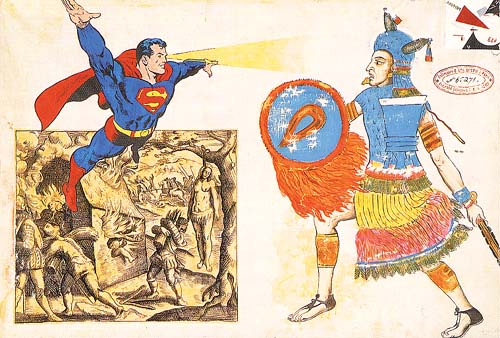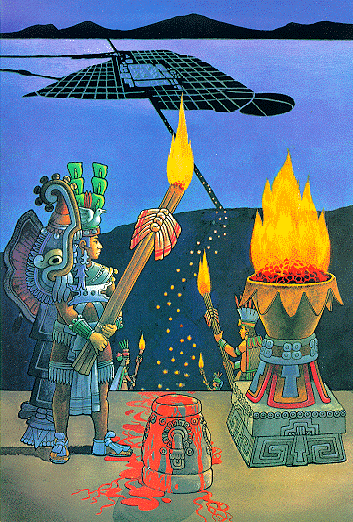 Another response to Was Native Defeat Inevitable?:
Another response to Was Native Defeat Inevitable?: Another response to Was Native Defeat Inevitable?:
Another response to Was Native Defeat Inevitable?:
>> It's interesting to speculate what would have happened without the Spanish intervention. During the 15th and 16th Centuries Tenochtitlan could have emerged as the head of a great early industrial state, and we would be driving XipeTotecmobiles and visiting newsgroups on Tlalchialoni CPUs. (probably communicating in Nahuatl to boot.) <<
Interesting indeed, Erik. The scenario is a lot more plausible than most people realize. As Ross Hassig, a professor of anthropology, writes in What If? The World's Foremost Military Historians Imagine What Might Have Been, Cortés's conquest of Mexico was mostly luck.
Here are the key points:
Governor Veláquez of Cuba relieved Cortés of his command before Cortés's expedition to Mexico. Cortés disobeyed orders and sailed anyway. When Veláquez learned of Cortés's knavery, he sent a fleet under Narváez to capture him.
Cortés defeated Narváez and continued his mission, but now he was a wanted man. If his undertaking hadn't succeeded, he wouldn't have gotten a second chance. The Aztecs would have gained a crucial breathing period.
Since Cortés relied heavily on rebellious Mesoamerican tribes, disease wasn't his ally against the Aztecs. It touched all the local inhabitants equally. With both sides reduced in number, it didn't directly determine the outcome.
Although Cortés was cunning enough to take advantage of the breaks, he had incredibly good fortune. Vassal nations chafing at the bit (so to speak, since they didn't have horses)...a weak adversary in the emperor Motecuzoma...and the instability sown by smallpox, ironically introduced by a sick man in Narváez's fleet. Cortés didn't plan these things, he lucked into them.
After his first attempt to take Tenochtitlán, Cortés fled and rallied his allies. In his second attempt, the Aztecs trapped him at one point on a causeway. Cortés escaped only because one of his soldiers sacrificed himself for his commander.
Without that happenstance, the Aztecs would have mounted Cortés's skull on a pole and then repulsed their enemies. Though another conquest attempt was likely, they would have had time to adapt. As Hassig puts it:
[B]y the time the Spaniards subjugated the peoples of the Andes, leaving them crippled with deadly disease and exploitation, and they finally turned their attention back to Mexico, in the mid to late 1530s, their opportunity had passed. The allies of a returning Spanish force would have been few, their victories ephemeral, and the lucky ones would have been pushed back into the sea—the heads of the rest would have adorned the skullracks of Tenochtitlán. Any reconquest would have to await far larger numbers, more artillery, and more horses than were available in the Indies.
While the Spanish were preoccupied, writes Hassig, the Aztecs would have investigated and adopted "swords, armor, crossbows, perhaps harquebuses, and maybe even horses." They would have learned how to use them from mercenary Spanish soldiers. Meanwhile, resolute Spanish missionaries might have introduced elements of Christianity, perhaps eliminating human sacrifice. And they might have brought literacy and the Latin alphabet to Mexico, increasing the Aztecs' political and administrative might.
The result? According to Hassig,
With the gradual emergence of a far stronger indigenous economy and the development of at least a tolerable approximation of Christianity, Mexico would have been far more difficult to conquer. Mexico could have continued as a regional power and survived the expansion of the European colonies in Central and North America, if their more limited exposure to Europeans dispersed the demographic shock of introduced diseases and they prevented Europeans from exploiting it. The nation that emerged may have been much like the Mexico of today, though perhaps limited to central Mexico, organized on strong indigenous lines, yet having undergone modern development from empire to constitutional monarchy.
The consequences for the rest of America's Native people would have been profound. A strong Mexican presence might have hampered US expansion toward the west, perhaps even halting it at the Mississippi River. With Mexican help, many Indian tribes would have retained their independence. The outcome, speculates Hassig, might have left "the United States of today far smaller and bordering a nation of truly indigenous Americans."
So, to answer the title question: No, Native defeat was not inevitable. A few lucky breaks and the world would have been a far different place.
Rob

Another take on the Aztecs's defeat
From An Interview with Charles C. Mann. In Indian Country Today, 12/25/05:
Disease probably played its greatest role in the destruction of the Triple Alliance (aka the "Aztec Empire") in central Mexico. Using a technique the Spaniards had discovered in the Caribbean, Hernan Cortes seized Motecuhzoma, the leader of the Mexica (the most important of the three groups in the alliance). This shocked the Mexica pretty much the way that Cromwell's seizure of the English King Charles did a century later in Britain. It took them a few months to get over it, but when the Mexica did they killed two-thirds of the Spaniards and most of their horses and threw them out of the city. The Mexica kicked Cortes' ass, to be blunt about it.
Wounded, almost each and every one, the Europeans were on the point of utter destruction when by a stroke of fortune smallpox came in with some Spanish ships that ended up providing reinforcements to Cortes ... Whatever the exact mechanism of transmission, the disease tore through the countryside.
Seeing that Cortes and his men were immune (they had been exposed during childhood), the Tlaxcalans -- the people of a large state that had been fighting off the Triple Alliance for decades -- made common cause with Cortes. When he returned to the attack, it was at the head of an army tens of thousands strong, and he was attacking an enemy whose military and political leadership had been killed off, almost to a man, by the disease. Fighting courageously, the enemies of the Triple Alliance won this second encounter, but the only reason it occurred at all was smallpox.
Now multiply these two stories by a hundred or a thousand and you get some idea of the enormous consequences wreaked by European diseases when they came to the Americas. Smallpox alone seems to kill about 40 percent of unvaccinated populations.
Related links
Adaptability and the Shock of the New: The Response of the Mexica to Cortes' Invasion
"Seven Myths of the Spanish Conquest" by Matthew Restall
Aztecs rule in Gate of Worlds
Native vs. non-Native Americans: a summary
|
. . . |

|
All material © copyright its original owners, except where noted.
Original text and pictures © copyright 2007 by Robert Schmidt.
Copyrighted material is posted under the Fair Use provision of the Copyright Act,
which allows copying for nonprofit educational uses including criticism and commentary.
Comments sent to the publisher become the property of Blue Corn Comics
and may be used in other postings without permission.